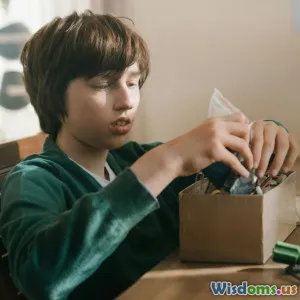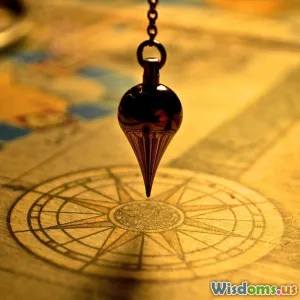
How to Foster a Love for Science in Children
8 min read Discover creative DIY approaches to inspire children’s passion for science through hands-on learning and exploration. (0 Reviews)
How to Foster a Love for Science in Children Through DIY & Handmade Projects
Science is everywhere—from the buzzing bees in the garden to the stars lighting up the night sky. But how can we translate this ubiquity into a deep-seated enthusiasm in children, especially in today’s fast-paced digital era? The answer might lie not just in textbooks or videos, but in the tactile and immersive world of DIY and handmade science projects. These projects don’t just teach facts; they cultivate curiosity, critical thinking, and wonder.
The Importance of Nurturing Scientific Curiosity Early
Numerous studies demonstrate that early encouragement significantly shapes children’s attitudes toward STEM (Science, Technology, Engineering, and Mathematics). A report from the American Psychological Association highlights that engaging children in exploratory play and problem-solving early can foster an enduring interest in science by boosting confidence and reducing anxiety around complex topics.
DIY science projects activate the brain’s natural learning processes through engagement and immediate feedback. By physically conducting experiments or creating models, children don’t just passively absorb information—they make discoveries on their own.
Crafting the Ideal Environment for Science Exploration at Home
Creating a scientifically stimulating environment at home is the foundation to building lifelong interest. This doesn’t require a high-tech lab but rather a dedicated science corner—complete with accessible materials, science kits, and notebooks for observations.
Example: Marie, a mother of three, created a "Science Discovery Box" filled with magnets, lenses, test tubes, and plant seeds. Each weekend, her children chose different objects to explore, sparking spontaneous conversations about magnetic fields or growth cycles.
Ensure the space encourages tinkerability where mistakes are welcomed. This approach builds resilience and teaches children that science often progresses through trial and error.
DIY Science Experiments That Captivate Young Minds
1. Homemade Volcanoes: The Classic Practical Chemistry
Volcano models using baking soda and vinegar captivate children with their explosive reactions. Beyond the spectacle, parents can introduce concepts of acid-base reactions and geological phenomena.
Step-by-Step Insight: Mixing a teaspoon of baking soda with vinegar inside a handcrafted clay volcano not only illustrates a chemical reaction but opens conversations about Earth’s processes and environmental science.
2. Growing Crystals: Patience Meets Chemistry
Creating salt or sugar crystals on strings is a fascinating slow-burn project that teaches children about solubility, evaporation, and molecular structure.
Scientific Value: This encourages observational skills and patience, as real crystal growth takes several days, reinforcing concepts of time scales in nature.
3. Hand-Constructed Circuits: Lighting Up Curiosity
Using simple homemade circuits with batteries, wires, and small bulbs introduces electricity and circuitry fundamentals. This hands-on project can evolve into understanding more complex topics like renewable energy or electrical safety.
Resources like the "Snap Circuits" kit recommend safe and educational tools.
Integrating Storytelling with Science DIY Activities
Children connect deeply through stories. Merging scientific concepts with storytelling allows for contextual learning.
For instance, while building paper airplanes, narrate the journey of the Wright brothers to explain aerodynamics history. This nurtures empathy and historical perspectives alongside scientific interest.
Leveraging Everyday Materials for Sustainable Science Learning
Encouraging the use of recyclable and household objects not only makes science accessible but also instills environmental consciousness.
Example: Creating water filtration systems using sand, charcoal, and gravel in plastic bottles demonstrates chemistry principles while promoting sustainability.
In one New York City middle school, students constructed these filters and compared water samples before and after filtration, illustrating real-world water purification challenges.
Encouraging Questions and Scientific Thinking
The core of science is inquiry. Prompt children to ask 'why' and 'how' rather than just 'what.'
Parents and educators can keep a "question jar" where children submit queries about the natural world. Each week, a family or class project can investigate one of these questions through DIY experiments.
This validates curiosity and builds investigative skills vital for scientific thinking.
Social and Emotional Benefits of Collaborative DIY Science
Engaging in hands-on science projects fosters social skills such as communication, teamwork, and patience. Group DIY experiments allow children to express ideas, listen to peers, and develop leadership qualities.
A research article from the "Journal of Educational Psychology" found that cooperative learning in science significantly improves understanding and retention in elementary children.
Tailoring Science Projects to Different Age Groups
- Toddlers (2-4 years): Simple sensory exploration like water play, color mixing with food dye.
- Preschool (4-6 years): Basic plant growing, movement experiments with balls on ramps.
- Elementary (7-10 years): Build small-scale circuits, explore magnetism, and chemical reactions.
- Tweens (11-13 years): Robotics kits, coding simple algorithms tied to DIY projects.
Customizing complexity not only matches developmental stages but keeps motivation high.
Real-World Role Models and Resources to Inspire
Highlighting the journey of scientists through videos or children's books—such as Katherine Johnson, who helped put men on the moon, or Leonardo da Vinci's inventive spirit—personalizes science.
Online platforms like NASA’s "STEM at Home" offer free, adaptable projects that meld well with DIY approaches.
Conclusion: Cultivating a Lifelong Curiosity Through Handmade Science
Fostering a love for science in children transcends passive learning. By intertwining the tactile joy of DIY projects with structured curiosity and open-ended questions, caregivers can inspire a generation of thinkers and innovators.
The act of creating, experimenting, and discovering by hand brings science to life—making it relevant, exciting, and deeply personal. In a world increasingly driven by technology and innovation, these foundational experiences can empower children not just to understand science, but to become active contributors to our collective future.
Encourage kids to embrace the messiness of experiments, cherish their questions, and most importantly, have fun—because the best scientists are those who never lose their sense of wonder.
Rate the Post
User Reviews
Popular Posts





















